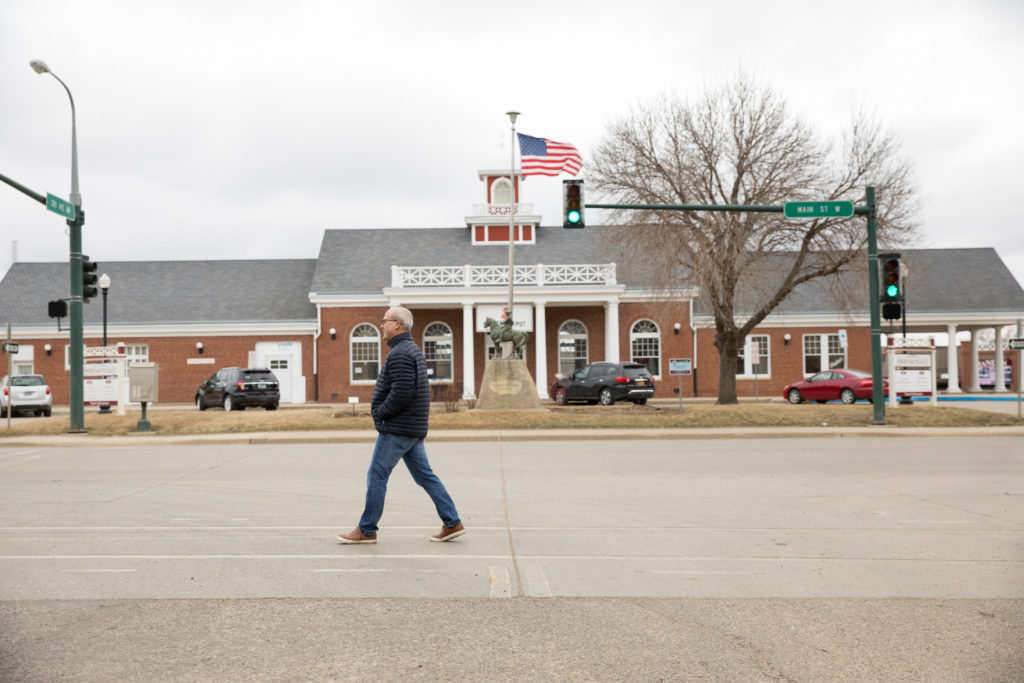Morton County, North Dakota: Rural Middle America

The Missouri River, lining the eastern boundary of Rural Middle America’s Morton County in North Dakota, is much more than a physical border between counties; residents point to the river as a cultural and psychological marker of two divergent work-life rhythms. To the east lies Burleigh County, containing the state capital, Bismarck, where people often conduct business and politics in suits and ties; to the west sits Morton, where many folks farm and go about town in jeans and cowboy boots. So ingrained is Morton County’s ranching culture that Mandan, the county seat, is home to the longest-running rodeo in America, held since 1879 for three days over the Fourth of July.
In Travels with Charley in Search of America chronicling his 1960 road trip, John Steinbeck captures the stark terrain in iconic fashion: “This is where the map should fold. Here is the boundary between the east and west. On the Bismarck side it is eastern landscape, eastern grass, with the look and smell of eastern America. Across the Missouri on the Mandan side, it is pure west, with brown grass and water scorings and small outcrops. The two sides of the river might well be a thousand miles apart.”
While residents recognize the benefit of their proximity to the political capital, they value their place apart. Morton County’s rural, western character has held through the ebbs and flows of its history. Founded in 1873, it grew up around the Northern Pacific Railroad — passenger trains stopped passing through in 1979; freight trains routinely run through downtown Mandan today. Some businesses are longtime fixtures, including Mandan Refinery that opened operations in 1954 and now can turn out 74,000 barrels of oil a day, and Cloverdale Foods, owned by the Russell family for more than 100 years — and expanding today.
Since the 2010 census, Morton County’s population has grown 12%, partly propelled by the recent oil boom in North Dakota. Situated some 200 to 300 miles from the oil fields, the county has become home for many traveling west to work for a couple of weeks at a time. In 2016, Morton became a battleground in the fight over the Dakota Access Pipeline.
Lately, Morton County’s growth has been evening out (pop. 30,796). Two telling signs: Housing is easier to find, and its affordability is becoming a priority. Other economic indicators point in a positive direction. The median household income is $63,300, higher than the $57,600 national median, while the county’s unemployment rate stands at 3%. Startups continue to pop up in repurposed buildings in downtown Mandan, where the incentives for entrepreneurs are robust.
Yet there are signs of strain. Residents say the current workforce is not keeping pace with the jobs available. On health, the health department in the county is working to meet residents’ significant needs on drug use and home visitations. Other challenges: Bridges and roads need attention; social services are deluged. How the county copes with such constant churn will test its pioneering, rugged sensibility. All are opportunities for Morton to draw on residents’ ingenuity and continue tapping its resources for new uses in the years ahead.
Morton County Index
Morton County Within Rural Middle America and Rural Counties Overall
A Farming Bedrock
Cultivating Talent and Business Development
Health Challenges and Promising Programs
Grappling With Social Ills
Innovations in Housing
Attending to Aging Infrastructure
Redefining Community Identity
Morton County Within Rural Middle America and Rural Counties Overall
The clearest way Morton County stands out in Rural Middle America is its population growth. Gaining 12%, the county counters the trend in this swath, where 74% of counties have lost population since 2010.
The population is 90% non-Hispanic white, 4% Native American, 3% Hispanic, and .5% Asian. This is slightly more diverse than in Rural Middle America, where the median is 93% non-Hispanic white, 3% Hispanic, 1% Asian, and 0% Native American.
A second reason Morton is better positioned than its rural peers: household incomes. While Rural Middle America’s median household income stands at $53,200; Morton’s is about $10,000 higher. The median of all rural counties is $46,600.
Compared with Rural Middle America and rural counties overall, the food environment index is high at 9, according to the 2019 County Health Rankings. In Rural Middle America, it’s 8.2; rural areas overall stand at 7.6. In Morton and rural counties generally, 7% have limited access to healthy foods, defined as being low-income and not living near a grocery store.
Another encouraging health factor: Just 9% report severe housing problems, slightly lower than in Rural Middle America and rural counties, where the rates are 11% and 13% respectively, according to the Rankings. This indicator takes into account overcrowding, severe housing cost burden, and inadequate facilities, such as no full kitchen.
The Rankings show several health challenges, particularly in health behaviors.
- The median adult obesity rate is 33%, which matches Rural Middle America and rural counties overall.
- Alcohol abuse is a major issue here. Excessive drinking stands at 25%, whereas the rate drops to 20% in Rural Middle America and 17% in rural counties overall. Along those lines, alcohol-impaired driving deaths are at 57%. Rural Middle America’s median is 28%, and the overall rural median is 27%.
- Morton’s premature death rate stands at 7,200. Rural Middle America is close behind at 7,100. Both fare better than the 8,641 median in rural counties overall.
Morton’s educational attainment levels convey mixed progress vis-à-vis its rural counterparts. Here 82% graduate from high school, lower than the 91% rate in Rural Middle America and the 90% rate in rural areas overall. And 72% of 25- to 44-year-olds have some post-secondary education. This is considerably better than the 62% rate in Rural Middle America and the 54% rate in rural counties overall.
On social capital, loosely defined as relationships and institutions that help people gain advantages in society, Rural Middle America’s social capital index stands at .45; Morton County falls below at .08. This index, produced by Penn State University’s Department of Agricultural Economics, Sociology, and Education, is made up of religious, civic, sports, professional, and labor organization variables.
A Farming Bedrock
The role of ranching and agriculture in Morton County’s economy cannot be overstated; more beef cattle are raised here than in any other county in North Dakota. Morton County contains 781 farms, whose average size is 1,570 acres, according to the 2017 Agricultural Census.
“Many of these ranches have been here since before the county was a county, even. Families have continued the operations. They’re pretty self-reliant. And they’re not inclined to complain about things very much,” says County Commissioner Bruce Strinden, who owns a ranch four miles outside of Mandan.
Morton County Farmers Union President Dan Belohlavek owns a 1,200-acre farm 10 miles southwest of Mandan, which his parents purchased in 1942. He’s carried on raising livestock and growing cash crops. Today, farmers’ No 1. concern is low commodity prices; trade is also an issue. “You’re just vulnerable to whatever the market trends are,” he says.
This stress is taking a toll on the farming community. “They don’t know how they’re going to pay the bills, or they don’t see a future,” Belohavek says, noting that the Farmers Union has outreach programs to help those struggling.
An odd drawback in this farming region: up-and-down access to fresh food, remarks Belohavek’s wife, Dawn, an auditor who works in Bismarck. “When we travel and go overseas, you get fresh food, fruits and vegetables, and here we are in rural America, and we don’t have access to that fruit and vegetables much.”
Despite such challenges, Belohavek sees young people interested in taking over their families’ farms. The Farmers Union runs a youth camp in Morton County, and FFA (Future Farmers of America) and 4-H are important pipelines.
Cultivating Talent and Business Development
The snow coming down sideways, the wind whipping ’round wouldn’t stop weekly Trivia Night from commencing at the Mandan Depot Bier Hall on Main Street, where 60-plus people packed in, eating, drinking, and playing a rousing game for a few hours in early April. Once the town’s train station, the converted restaurant was one of three establishments Edgar Oliveira owned downtown. Since April, things have gotten tougher for Oliveira’s restaurants; the Depot closed on June 30. “There has been a number of new places that opened in Bismarck and Mandan. The increased competition has not been kind, and there seems to be an overall drop in people going out to eat,” he says.
A native Brazilian who previously lived in Santa Barbara, California, Oliveira explains why he continues to like living in a smaller community like Morton County. “There’s a lot of room to create things here.”

At the Mandan Depot Bier Hall, entrepreneur and restaurateur Edgar Oliveira describes the nightly scene in Mandan, the changing labor market, and his businesses’ ups and downs.
As Ellen Huber, business development and communications director for the city of Mandan, says, “We’ve carved out Mandan as a fun place to be, and we’re proud of the community events we host.”
For many years, growth downtown was blocked by diesel fuel contamination coming from Burlington Northern rail yard fueling activities. In the mid-1980s, more than 3 million gallons of petroleum were found under the downtown, curtailing investment. In 2004, a $30.25 million settlement went toward cleanup and related impacts. Now there’s a sense things have turned a corner. When Huber started in the role in 2006, Mandan’s property tax base was 25% commercial; as of 2018, it’s up to 33%.
The city has developed different assistance tools for businesses. Bank of North Dakota’s Flex PACE program buys down the interest rate for a business that the local community deems important, and the community must put down a 35% match toward that interest buy-down — a program available for new and expanding businesses. A three-year restaurant rewards program that ended in March offered new and expanding restaurants a 1% local tax rebate for five years. “We have seven new restaurants open now, and three to open in 2019,” Huber says. A retail incentive program provides a stipend on a per square foot of operating space for the first 12 months of operation.
In general, meeting workforce demand is difficult. “We have a lot of great business career opportunities, and we can’t have people trained and ready to go into the workforce fast enough. We need to attract people from beyond our state. We can’t just keep shifting workforce around or cannibalizing from one business to another,” Huber says.
Workforce development is one of the major challenges Mandan Public Schools Superintendent Mike Bitz sees. In his nine years at the helm, the school system has grown from just above 3,000 to more than 4,000 this school year. Some growth can be attributed to the oil boom; Cloverdale Foods, too, has recruited workers from far away, including Puerto Rico and Guam. “It’s hard for us to attract and retain people to work. Unemployment is so low…. Several of our paraprofessionals and cooks will do something else over the summer and not come back to us. They’ll find something that pays better,” Bitz says.
In the schools, student body diversity has increased as a result of new arrivals. “We went from a handful of English learners when I came here to 120 now,” Bitz says. An achievement gap persists, particularly with Native American students. After finishing school, about 70% of the senior class enroll in higher education, many to Bismarck State College across the river. About 5% go into the military, the others to the workforce, Bitz says.

While Mandan has the largest district in Morton, there are four smaller school districts in the county’s other towns: Flasher, Glen Ullin, Hebron, and New Salem-Almont’s consolidated district.
“On workforce development, we’re working with our K-12 schools and higher education. We’re also looking at how do we retain as many of those young people as possible, and how do we bring them back home,” Huber says.
Health Challenges and Promising Programs
Keith Johnson, administrator for Custer Health, encompassing Morton, Grant, Mercer, Oliver, and Sioux counties, articulates an overarching problem that hampers his department’s work. “In Morton County, one of the major challenges is a lack of a social infrastructure; there are no leading institutions around which to address health problems or any other problem.” Custer Health’s Director of Nursing Jodie Fetsch adds that this makes it difficult to build coalitions. “We just started a coalition again, and it’s tenuous to keep it.”
The community health needs assessment has outlined obesity, physical inactivity, substance abuse, and mental health issues as key concerns. In 2018, the Centers for Disease Control reported that the suicide rate in North Dakota jumped more than 57% between 1999 and 2016 — the highest in the country.
“I know opioids have made a big splash nationally. We’re certainly taking steps regarding that. But meth is still the substance of choice around here. Of our syringe exchange clients, I would say 80% are tweakers,” Johnson says.
In January 2018, Custer Health began a rigorous syringe exchange program with the North Dakota Department of Health, the first one in the state. “They have to bring in dirty syringes to us before they can get clean syringes, and we test them every six months for HIV and Hepatitis C,” Fetsch says. Today, 165 people are on the program.
“About half of them are Hep[atitis] C positive. And of the half that have come in not Hep C positive, we have not had any serial conversions since we started the program,” Johnson says.
Custer Health is continuing home health visitation with the full backing of its board of health; the department charges clients based on income, and most do not pay a fee. “One-on-one services are not where public health is supposed to be. But there was an absolute demand, both among decision makers and our population. It’s one of the most valued things we do,” Johnson says. “That is going to continue despite the trend nationally.”
Residents also have access to a hospital in Mandan. Vibra Hospital of the Central Dakotas, a long-term acute care hospital, treats patients with chronic conditions, such as cancer, heart disease, and traumatic injuries.
For particular programs, Medicaid expansion has been essential, Johnson says. These include Women’s Way, screening for breast and cervical cancer; and Health Tracks, providing screenings and well-checkups for children and young adults. North Dakota expanded Medicaid with federal funding in 2013, with coverage effective in 2014. Today, the program covers about 20,000 residents statewide.
Grappling With Social Ills
Morton County’s Social Services Department that Dennis Meier oversees has its hands full, handling eligibility for Medicaid, Medicaid expansion (the Affordable Care Act), TANF, heating assistance, child protection, foster care, in-home, daycare and foster care licensing, and home and community-based services for elderly and disabled residents. The department was servicing 3,500 residents, according to the county’s recent monthly data.
For those needing child protection services, internal documents report that approximately 75% of cases involve drugs and/or alcohol use, and prenatal exposure to drugs and alcohol is on the rise, Meier says. In recent years, he’s recognized new populations have entered the community, and this has strained available resources. (The department’s budget for the 2019 fiscal year is $3.275 million.) Children entering the foster care system are younger than they were 10 years ago, some five- and six-years-old, with more behavioral challenges, such as aggression.
Underway now is a major structural and cultural change for delivery of social services, as North Dakota’s legislature in April approved redesigning counties into regional “human service zones.” The 52-county social services offices have until December 1 to create up to 19 multi-county human service zone agreements stating their intentions to form into zones. Meier notes that today, Morton County maintains strong relationships with smaller counties to the south and southwest, Grant and Sioux, and acts as the resource hub for its rural neighbors. Therefore, it would only make sense that Grant, Morton, and Sioux Counties form a zone, he adds. Zone boards have until March 31, 2020, to hire directors for each zone.
With the redesign, Meier says he looks forward to social workers spending more time with families in the field and fewer layers of bureaucracy, which has prevented his team from focusing on other important duties. The redesign, Meier says, also opens the way to better communicate social services’ work and may involve convening community forums. “We’re more than just an agency that disseminates SNAP and Medicaid Services. We’re here to help people who are poor and vulnerable and make sure children are safe…. There’s a problem when people would rather have law enforcement at their door than us,” Meier says.
Meanwhile, violent crime has been ticking slightly upward in Morton, with 223 incidents per 100,000 population, according to the 2019 County Health Rankings. In 2016, the rate was 199. In early April, Mandan was rocked by a quadruple murder at RJR Maintenance and Management, a property management firm. The man charged was a chiropractor and Navy veteran living in a mobile home park managed by RJR. “That hurts everybody’s heart, because we just don’t have those kinds of things going on here,” says Strinden.
Innovations in Housing
Community leaders describe how some people choose to live in Mandan because home prices are lower here than in Bismarck. For Mandan, the median value of owner-occupied housing was $194,300 between 2013 and 2017; for Bismarck, it was $223,200, according to census figures. Over the same period, the median gross rent in Mandan was $849; in Morton County, it was $839. Bismarck’s was $821.
In a move forward on affordable housing, the North Dakota Housing Finance Agency helped provide the financial support to redevelop a key landmark in Morton County. Historic Apartments On 4th opened in December 2018 at the old Mandan Junior High within walking distance to Main Street. It contains 39 units for individuals and families with comfortable square footage, ranging from around 600 to nearly 1,500.
The complex is just about full; three one-bedrooms run between $600 and $615 a month, 22 two-bedrooms range from $499 to $690 a month, and eight three-bedrooms run from $567 to $775 a month. To qualify, a household’s income cannot exceed 50% of the median family income. For one person, that’s $32,200; for two, it’s $36,800; for four, it’s $46,000. Six service units have been reserved for homeless, as the county doesn’t have a shelter.
The structure is a mix of old and new — the redevelopment of the housing project cost more than $8.8 million. The original school building was finished in 1917, with the three adjoining buildings erected in 1924, 1954, and 1977. In a unique set-up, the school lockers, original wood railings, and terrazzo floors remain intact. The old gym is now a community room; there’s a laundry room, exercise room, elevator, secure entry, and on- and off-street parking. New artwork graces the halls. A private playground exists on-site, and a daycare space big enough for 12 residents’ children is ready and waiting for a license.
Historic Apartments On 4th is managed by Kaycee Boehm, the on-site property manager with MetroPlains, a real estate development and property management firm, which also specializes in compliance training for government programs, including the Department of Housing and Urban Development and Housing Tax Credit programs.
To help area residents, the Morton County Housing Authority, managed by HJL Management, administers the housing voucher program in Morton, Grant, Sioux, McLean, and Oliver counties. How it works: The client pays 30% of income for housing, which includes rent and utilities; the Housing Authority supplies to the landlord the difference between the client’s amount and the contract rent. HJL Management’s Housing Specialist Wanda Schmidt and Accountant Stacy Kramer say a major challenge they face is that potential tenants have trouble passing background checks, in part because of the drug epidemic.
The county also has been expanding its housing options beyond single-family homes to townhomes, multi-dwelling units, and senior living since Morton County’s Comprehensive Housing Study was released in 2014. For one, HJL manages Liberty Heights, a 55-plus community that contains 178 units. Townhomes and condos, too, are more available now. “Before when there was a unit, it didn’t take long to fill it. And now they’re sitting empty,” Kramer says. And why? “I think we finally caught up to the need,” she replies.
Attending to Aging Infrastructure
About 1,200 miles of gravel roads and just 108 miles of asphalt cover Morton County, meaning less than 10% of county roads are paved, according to County Engineer John Saiki. While the roads are generally in good condition, we have to overlay those paved with asphalt in the next five to six years to preserve them, Saiki says. “We don’t have enough money to really expand or improve,” he adds, noting that his budget runs $6 million a year. “Same thing with our gravel. The more good quality gravel, the more passable the roads are.” The county spends about $750,000 a year to keep up gravel roads.
Morton counts more bridges — 216 — than almost all other counties in western North Dakota. Forty-eight are inspected by Saiki and his team, the rest by the state. Built with timber in the 1950s and 1960s, many need upgrading, some replacing, Saiki says, adding that the county spends about $400,000 a year to maintain and repair its bridges.
Morton County hopes for a boost from the state’s new Operation Prairie Dog law, signed by Gov. Doug Burgum (R) in March. Totaling $250 million, the operation adds new categories to the state coffers filled by oil tax revenue, and will be given to city, county, township, and airport infrastructure projects in North Dakota. Counties and townships can receive up to $115 million. Money will become available for projects in mid-2021.
Redefining Community Identity
As the county’s aforementioned sectors undergo change, a new generation is emerging in the uncertainty. It used to be that many residents left after high school and returned later to raise families, according to the Morton County 2045 Comprehensive Plan. This has changed lately, as 18- to 24-year-olds made up the fastest growing age group between 2010 and 2016.
For Keith Johnson, the health administrator who’s retiring this year, it’s a heartening sign. “We’ve got a generation coming up whose ideals and social mores are more advanced than the generation that’s leaving.”
The demographic shift requires reimagining how the community functions — work that remains unsettled, according to Johnson. “When we were talking about the lack of social infrastructure, fraternal organizations and churches were the social drivers, and they were largely because this was a vertically integrated community. You had a grandpa and a son or daughter, and the kids and grandkids were all part of that church. This vertical integration has disappeared.
“And we haven’t figured out how to horizontally integrate groups and make them matter to each other. For one thing, millennials don’t go to places to be part of groups. That doesn’t mean they don’t want to do community things. We haven’t figured that out yet. We just haven’t,” Johnson concludes.


